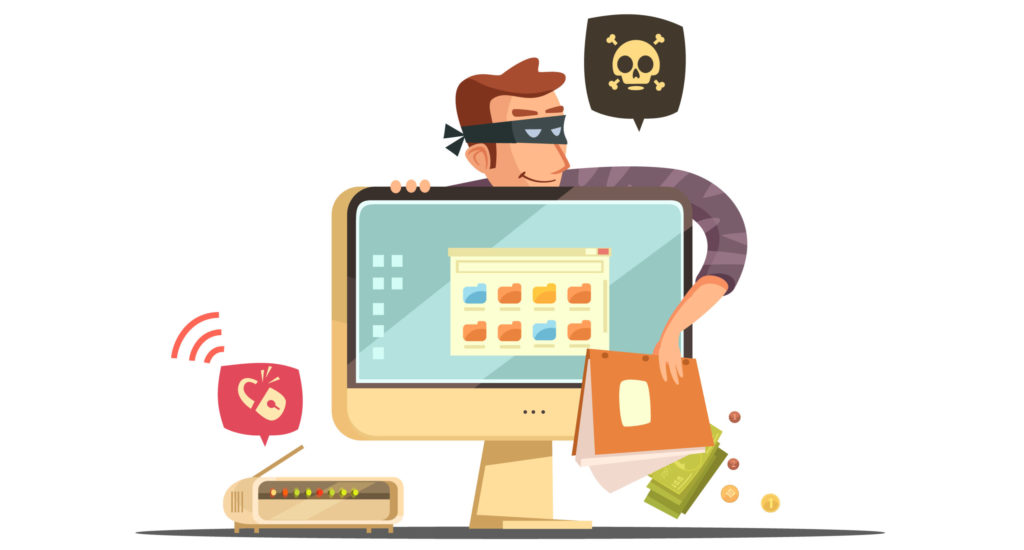
Password Sharing Isn’t a Victimless Activity
Back when DVDs were first being introduced the industry’s — and undoubtedly content creators’ — biggest concern was making them so they couldn’t be copied. They really wanted to lock things down … permanently.
No one wanted to follow in the RIAA’s (Recording Industry Association of America) footsteps: share our stuff with your friends, we’ll take you to court and take you for everything you have.
One case they won was against a curly-haired 12-year-old that cost her single mom living in the NY projects $2,000. That didn’t sit well with no-BS New Yorkers or other adults around the country.
To proactively sidestep that awkward situation for DVD content, engineers/software developers produced a small piece of software that would go from the disc to the player, be recognized as a legal copy and BAM! you could watch your movie.
The problem was solved but … It only took a couple of weeks for some super smart kid to capture that approval code when it was unprotected — less than a second — and the key was suddenly available everywhere on the global internet in less than a day.
Instead of being the heavies, the industry convinced the government to give it an ugly warning as a reminder that copying/sharing is a no-no.
 It doesn’t really work but …
It doesn’t really work but …
Sure, some people still “rip” (copy) DVDs, but various shades of new techniques of “borrowing” movies/shows have only gained in momentum. The easiest way is to visit one of the pirate sites that cost them nothing. Tell some people you can watch the latest content and it’s all free … and they’re there.
It doesn’t matter that those sites give viewers something extra — malware — or that they get paid with the viewer’s account/activity data, personal information and just about any stuff they find to sell to … others.
Of course, content providers and streamers aren’t happy about the pirate sites making money from their investments and work with government agencies locate/prosecute the sites. They don’t care about the pirate viewers, they suffer enough.
However, shutting down big-volume pirate sites is vital according to the latest DataProt report:
• Pirated video material gets over 230 billion views a year
• More than 80 percent of global online piracy can be attributed to illegal streaming services
• Digital video piracy is costing the US economy between $29.2 billion and $71 billion each year
• 126.7 billion viewings worth of U.S.-produced TV episodes are pirated every year
• Annual global revenue losses from digital piracy are between $40 billion and $97.1 billion in the movie industry
• Illegal downloading of copyrighted materials takes up 24 percent of the global bandwidth
Those losses are not insignificant! It’s a lot like playing whack a mole … shut down one, another emerges. It sounds futile but the industry needs to shut the pirate sites down and take back that lost income.
It could have funded 10s of thousands of film/show projects around the globe, keeping millions of script writers, producers, directors, filmmakers, production, and post people busy.
It might even have kept finished/nearly finished projects from being shelved by some studios for “tax purposes.”
Of course, there are also millions of people who wouldn’t be dumb enough to scrounge around looking for free stuff in those kinds of places because … they’re too smart for that.
There’s really no need for that in today’s streaming marketplace, especially if you lower your expectations to see the latest and greatest release and just want some entertainment.
Ad-supported services can offer you more movies, more shows than you can watch in a lifetime and they’re free.
Sure, you must watch a few ads, but with what the data streaming services have collected on your search/viewing habits, you probably won’t even mind. Remember … it’s free.
We’ve found a bunch of movies/shows we like on FreeVee, Tubi and PlutoTV (there are many more free services around the globe) that we didn’t even know existed.
Some were released in 1994, some in 2000, some in 2014.
So what? We’ve never seen them before, so they’re new … to us. Some were great. Some were good. Some you wondered how they got greenlighted. Others were obviously a tax write-off.
 However, if you really must watch the latest and greatest so you have something intelligent to add about the content that is sweeping the social media news cycle, there are safer ways to get the content.
However, if you really must watch the latest and greatest so you have something intelligent to add about the content that is sweeping the social media news cycle, there are safer ways to get the content.
Simply sign up for the service, watch everything of theirs you want to see and then cancel at the end of the month.
Done and done!
Of course, the bosses and financial analysts don’t like that because you’re supposed to sign up, fall in love with their movies/shows and stick around for a couple of years … or longer.
According to a recent report from Bitmovin, more than half (57 percent) of Americans haven’t canceled any streaming service since initially signing up despite economic uncertainty.
Value for the money (54 percent), availability of their favorite content (48 percent) and the ability to stream their entertainment (25 percent) across all devices were key reasons for keeping their subscription. Most (68 plus percent) indicated that they’ve come to appreciate the ad-free experience. Sure, they’d consider the ad-supported offering, but three-four SVOD services cost less than $50. That’s a lot less than the $100-$150 old cable bundle they escaped.
We recognize that your entertainment budget is certainly a factor in the stay vs. drop/swap decision. That’s why people cancel/add/replace/return to their paid streaming services from time to time. It’s called churn. Truthfully, it’s a great way to see the latest stuff HBO Max, Paramount + or whoever has released and still maintain a reasonable streaming entertainment budget.
Our neighbor has a “core” of three subscription services. About once a quarter, he’ll sign up for a fourth service for a month, catch up on their latest stuff, drop them for six to nine months and then repeat the process again. It’s a real inexpensive way to empty his viewing bucket list, fill it with new content, repeat the process and keep a “reasonable” entertainment budget. It’s called “service-hopping” and it’s perfectly legal.
According to Statista, Brazilians are best at it. More than 38 percent of the people asked said they had cancelled a subscription in the past six months. In the Americas, churn rate is 37 percent. Churn is highest with Gen Zers and millennials because they tend to be less brand loyal than with boomers and Gen Xers.
We get it. No one in the SVOD business likes service-hopping – popping in/out of streaming subscriptions – but it’s a fact of doing business and is a constant reminder for them to be better. It’s also why only short-sighted studio/streaming bosses think that shaving the content development budget is a smart move.
Steady/consistent investment in high-quality films/shows, constantly improving the online experience and enhancing perceived value are what keeps subscribers.
Focusing on a service’s MAU (monthly active users) versus constantly chasing new subscribers is the smartest measure of long-term profitability. In addition to churn, there’s another method of enjoying the newest content that some people feel is perfectly okay and steamers have turned a blind eye to for years … subscription-sharing.
We’re certain Netflix, Disney +, Amazon Prime and Apple TV+ know there are four people in our family who sometimes watch different stuff at the same time, on different screens – big screen, computer, smartphone – and sometimes, in different locations.
But it’s all in the same family so, they probably don’t mind … too much.
 However, the idea of sharing our subscriptions with our in-laws/out-laws, the guy in the next office or friend at the club isn’t something we’d entertain.
However, the idea of sharing our subscriptions with our in-laws/out-laws, the guy in the next office or friend at the club isn’t something we’d entertain.
Netflix — and all SVOD services (even though they only whisper about it) — have said that while they have about 223M subscribers, there are about 100 million households worldwide that were watching for free using someone else’s subscription password.
In the early days of SVOD, services bragged about the added viewership and suggested that it was part of their marketing budget.
But the industry is maturing and most of the services say it’s time to crack down on the millions of freeloaders who watch their films/movies by sharing friends, family passwords. Leichtman Research estimates that cracking down on password sharing could add substantially to their bottom line. Outlining the company’s focus on reducing password sharing, Netflix Co-CEO Reed Hastings told shareholders, “We’ve just got to get paid at some degree for them.”
Netflix isn’t alone. It’s affecting every streaming service … everywhere.
Parks Associates estimates that account sharing could cost the industry $9B by 2024. Barlovento Comunicación estimates that 40 percent of Spain’s SVOD customers will be affected when the common practice of password-sharing is ended.
There are mixed views on how cracking down on the practice will affect services. One not-so-close friend said, “If they start cracking down on password sharing and I’m stuck paying the full $15 (a month) bill, I’ll probably cancel.”
Jeezz … that’s less than 10 cups of coffee a month and a lot more refreshing.
And where are you going to go if everyone decides it’s time to get paid for the entertainment the create/provide? Morning Consult found that if password-sharing was no longer available, 50 percent of folks indicated they would pay for their streaming entertainment.
 Given the option of ad-free subscriptions vs. a less-expensive ad-supported service, the majority suddenly decided that ads aren’t that bad. More than 57 percent of consumers in the Americas said they’d opt for ad-supported services, 64 percent of South Koreans agreed; and only 37 percent of Japanese adults indicated they would sign up for the less-expensive service.
Given the option of ad-free subscriptions vs. a less-expensive ad-supported service, the majority suddenly decided that ads aren’t that bad. More than 57 percent of consumers in the Americas said they’d opt for ad-supported services, 64 percent of South Koreans agreed; and only 37 percent of Japanese adults indicated they would sign up for the less-expensive service.
Several industry analysts said other SVOD services will probably let Netflix be “the canary in the mine” to test consumers response and may even say “Hey we don’t mind your sharing. Come on over!”
But most sane people say the other services will follow suit because well, streaming content is a business and the people who invest in those businesses like to see the company make a profit and pay a dividend.
Most people just need a little nudge to do the right thing, even if it means watching a few ads with their entertainment.
Us? If they continue investing in new, interesting original content, we’ll pay the full subscription fee and enjoy our content without any ad interruption. For the folks who decide it’s better to rearrange the deck chairs by cutting jobs and trimming the content development budget, we may go for their cheaper ad-supported service or maybe just wait for them to be acquired by a more professional organization.
Regardless of which path content creators/distributors take, they have to pay attention to the lost income from video piracy and credential sharing because both have a negative impact on the entire industry–including the consumer.
We need to remember what Bobby Pappas said in The Greatest Beer Run Ever, “You got a good heart Chick. It’s your brains I’m worried about.”
Folks may not like it, but the industry needs to take a stand.
You know, have the kids from Strang Things knock on doors and tell the adults … Don’t Steal Our Stuff!
Andy Marken [email protected] is an author of more than 700 articles on management, marketing, communications, industry trends in media and entertainment, consumer electronics, software and applications.
